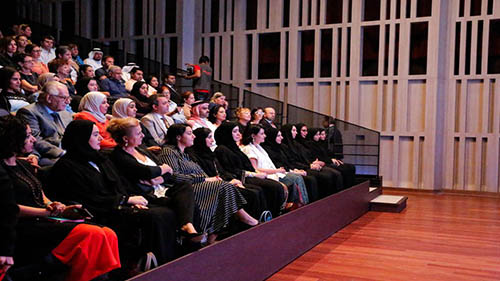Contact Center
.
23 October 2019
Commemorating the 500th anniversary of Leonardo da Vinci's Death, The National Theater Hosts a lecture on Leonardo Da Vindi


Bahrain, like other cities around the world, is commemorating the 500th anniversary of Leonardo da Vinci’s death, in an event organized by the Bahrain Authority for Culture & Antiquities, in collaboration with the Embassy of Italy in the Kingdom of Bahrain, on 23 October 2019. The event was attended by H.E Shaikha Hala bint Mohammed Al Khalifa, Director-General of Culture and Arts at the Bahrain Authority for Culture & Antiquities, H.E Mr. Domenico Bellato, Italian Ambassador to Bahrain, as well as a great number of artists and culture enthusiasts in the Kingdom of Bahrain. The Flexi Theater lecture titled “Leonardo da Vinci: Art, Science, and Natural Wonders” was given by Prof. Marco Ruffini and moderated by Dr. Balquees Fakhro.
His Excellency, the Italian ambassador, Mr. Domenico Bellato, expressed his thanks to Bahrain Authority for Culture & Antiquities for hosting such a valuable creative artistic lecture, adding that this event clearly reflects the strong historical cultural relations between Bahrain and Italy, shared views regarding the promotion of cultural activities in all aspects, and a constant support to dialogue, and preservation of cultural and world heritage. The Italian Ambassador also argued that this lecture marks the 500th anniversary of the Italian master’s death, an event celebrated all-over the world, tries to sketch out as complete a picture of the artist, scientist and thinker as possible.
Rome University Professor Normal, Marco Ruffini shed lights on the “timeless and universal genius” of Leonardo da Vinci, a symbol of Italian culture and Renaissance, the most celebrated artist and scientist of the Italian Renaissance and his multifaceted talent in almost every field of knowledge--ranging from mechanical engineering to human anatomy--has been widely recognized throughout the past five centuries. Prof.Marco Ruffini also highlighted the versatility of Leonardo’s genius in the art-historical context of his time and emphasize the intimate connection between his most celebrated paintings and his fascination for natural wonders. Prof.Marco Ruffini added saying although his exhaustive personal interests led to his mastery of multiple fields, he is widely considered one of the greatest painters of all time, Leonardo was a polymath, someone whose level of genius encompassed many fields including invention, painting, sculpture, architecture, science, music, mathematics, engineering, literature, anatomy, geology, astronomy, botany, writing, history, and cartography, he added. Prof.Marco Ruffini said that despite his exhaustive explorations into multiple areas of expertise, Leonardo is primarily celebrated as a painter. Some of his works have consistently been regarded with a timeless, universal fame such as his enigmatic portrait The Mona Lisa, his most reproduced religious work of all time, The Last Supper, and his the Virgin of the Rocks (sometimes The Madonna of the Rocks), an early instructive drawing of precise spatial and anatomical symmetry.
Worth to mention that Prof. Ruffini is a professor of Art Criticism and Art Literature at the University of Rome, “La Sapienza”. He studied at La Sapienza (B.A. and Diploma di Specializzazione in Art History), at the Academy of Fine Arts of Rome (B.A.), at Indiana University (M.A), and at the University of California, Berkeley (Ph.D.). Fellow at The Warburg Institute and Yale University, he also taught at Dartmouth College (2005) and Northwestern University (2005-13).







